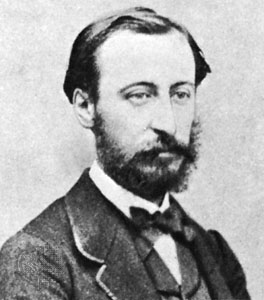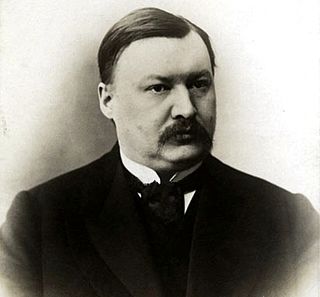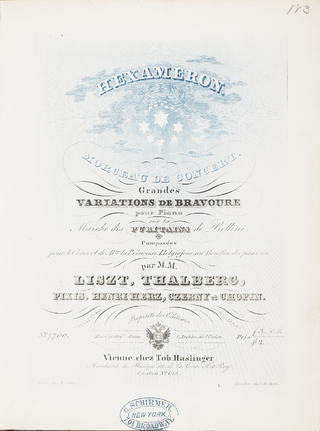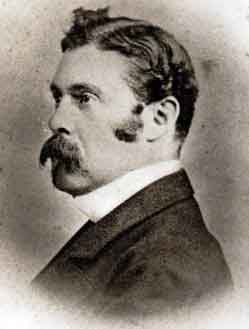Pyotr Ilyich Tchaikovsky's Trio in A minor, Op. 50, was written in Rome between December 1881 and late January 1882. It is subtitled À la mémoire d’un grand artiste [In memory of a great artist], in reference to Nikolai Rubinstein, his close friend and mentor, who had died on 23 March 1881. It is scored for piano, violin, and cello.

The Piano Concerto No. 4 in C minor, Op. 44 was composed by Camille Saint-Saëns in 1875. It was premièred on October 31, 1875, at the Théâtre du Châtelet of Paris, with the composer as the soloist. The concerto is dedicated to Anton Door, a professor of piano at the Vienna Conservatory. It continues to be one of Saint-Saëns' most popular piano concertos, second only to the Piano Concerto No. 2 in G minor.
Violin Concerto No. 2 in D minor, Op. 22, by the Polish violin virtuoso, Henryk Wieniawski, may have been started in 1856, but the first performance did not take place until November 27, 1862, when he played it in St. Petersburg with Anton Rubinstein conducting. It was published in 1879, inscribed to his dear friend Pablo de Sarasate.

The Violin Concerto in A minor, Op. 82, by Alexander Glazunov is one of his most popular compositions. Written in 1904, the concerto was dedicated to violinist Leopold Auer, who gave the first performance at a Russian Musical Society concert in St. Petersburg on 15 February 1905. The British premiere of the concerto followed just over a year later, under the direction of Sir Henry Wood and with Mischa Elman as soloist.
The Symphony No. 5 in B-flat major, Op. 55, was written by Alexander Glazunov from April to October 1895. Although in this symphony Glazunov returned to his conventional four-movement layout he frequently utilizes thematic transformation.

Hexaméron, Morceau de concert S.392 is a collaborative composition for solo piano. It consists of six variations on a theme, along with an introduction, connecting interludes and a finale. The theme is the "March of the Puritans" from Vincenzo Bellini's opera I puritani.

Alisa Weilerstein is an American classical cellist. She was named a 2011 MacArthur Fellow.
Hyacinthe Jadin was a French composer who came from a musical family. His uncle Georges Jadin was a composer in Versailles and Paris, along with his father Jean Jadin, who had played bassoon for the French Royal Orchestra. He was one of five musical brothers, the best known of whom was Louis-Emmanuel Jadin.

La stravaganza [literally 'Extravagance'], Op. 4, is a set of concertos written by Antonio Vivaldi in 1712–1713. The set was first published in 1716 in Amsterdam and was dedicated to Venetian nobleman Vettor Delfino, who had been a violin student of Vivaldi's. All of the concertos are scored for solo violin, strings, and basso continuo; however, some movements require extra soloists.
The Concerto in E flat major for alto saxophone and string orchestra, Op. 109, was written by Alexander Glazunov in 1934. The piece lasts about fourteen minutes and is played without pause. It is deeply rooted in Romanticism, and has entered the standard saxophone repertoire.

Nikolai Rimsky-Korsakov composed his Piano Concerto in C-sharp minor, Op. 30, between 1882 and 1883. It was first performed in March 1884 at one of Mily Balakirev's Free Music School concerts in St. Petersburg.
Pyotr Ilyich Tchaikovsky composed his Orchestral Suite No. 3 in G, Op. 55 in 1884, writing it concurrently with his Concert Fantasia in G, Op. 56, for piano and orchestra. The originally intended opening movement of the suite, Contrastes, instead became the closing movement of the fantasia. Both works were also intended initially as more mainstream compositions than they became; the fantasia was intended as a piano concerto, while the suite was conceived as a symphony.
Alexander Glazunov composed his Symphony No. 3 in D major, Op. 33, in 1890, and it was published by 1892 by the Leipzig firm owned by Mitrofan Belyayev. The symphony is dedicated to Pyotr Ilyich Tchaikovsky and was first performed in St. Petersburg in December 1890 under the baton of Anatoly Lyadov. The symphony is considered a transitional work, with Glazunov largely eschewing the influences of Balakirev, Borodin, and Rimsky-Korsakov inherent in his earlier symphonies for the newer influences of Tchaikovsky and Wagner. Because of this change, the Third has been called the "anti-kuchkist" symphony in Glazunov's output. He would tone down these new influences in his subsequent symphonies as he strove for an eclectic mature style. The Third also shows a greater depth of expression, most evident in the chromatic turns of its third movement, reminiscent of Wagner's opera Tristan und Isolde.

Marie-Alexis de Castillon de Saint-Victor was a French composer.
The Symphony No. 8 in E-flat major, Op. 83, was composed by Alexander Glazunov in 1905, and was published two years later. This four-movement symphony was premiered on December 22, 1906 in Saint Petersburg, the composer conducting. It was an important influence on Igor Stravinsky's Symphony in E-flat.
The Symphony No. 6 in C minor, Op. 58, was composed by Alexander Glazunov in 1896, and was published two years later. It is dedicated to Felix Blumenfeld.
The Piano Quartet No. 2 in G major, Op. 26 by Henrique Oswald was composed in the second half of 1898. It is scored for piano, violin, viola and cello. The approximate duration is 25–30 minutes.








